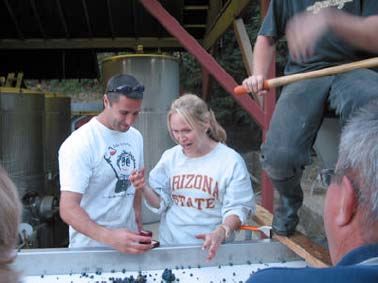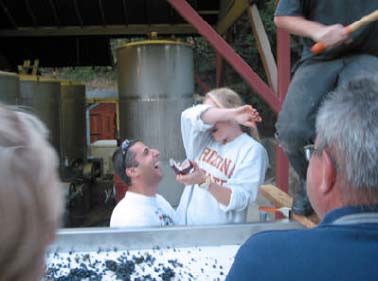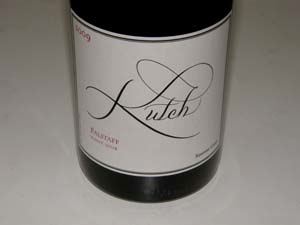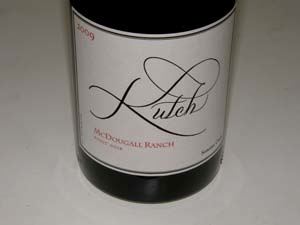Kutch Wines: Following Your Pinot Dream
When I first met Jamie Kutch at Kosta Browne Winery in May 2005, he was a greenhorn winemaker learning
the craft at the side of Michael Browne who was fashioning his wines in a section of the caves at Freeman
Winery in Sebastopol. Jamie’s story is a familiar yarn, played out many times in the last decade by currently
successful winemakers such as George Levkoff (a former bond trader who is the owner and winemaker at
George Wines), Thomas Rivers Brown (an English literature major at University of Virginia and now owner and
winemaker at Rivers-Marie), and Thomas Houseman (a former professional modern dancer who is now the
winemaker at Annie Amie in Oregon). These individuals are but a sampling of those who left behind a different
life to pursue Pinot Noir winemaking.
In early 2005, I received a curious e-mail from a PinotFile reader in New York who related to me that he had
spent the better part of a week staying awake until 3:00 AM reading past issues. He went on to tell me he had
learned an enormous amount about Pinot Noir and wouldn’t stop until he had read every issue. My ears perked
up when he told me he was leaving his career on Wall Street to make Pinot Noir in the Russian River Valley.
Jamie had lived his entire life in New York City. A Fordham graduate, he was working as a NASDAQ trader
with Merrill Lynch, commuting daily to Manhattan on the Long Island Railroad. At a young age, he developed an
interest in wine and for a few years even made wine in his small apartment with grapes shipped out from the
West Coast. The more he read and tasted, the more his passion grew. His Pinot Noir epiphany came when a
friend shared a glass of 1999 Domaine de la Romanee-Conti La Tache. He recalled it fondly, “It simply blew my
mind.”
In 2003, while at home after a day at work on Wall Street, he was surfing the eRobertParker Bulletin Board
and fortuitously stumbled upon Andrew Vingiello. Andrew also worked for a Wall Street firm, but on the West
Coast. He told Jamie he was mentoring under winemaker Brian Loring at night and making his first vintage of
Pinot Noir under his new label, A.P. Vin. The two communicated by e-mail and eventually Andrew sent Jamie a
barrel sample of his wine which impressed at a New York wine tasting along side other California Pinot Noirs.
Jamie was now really hooked and realized that Andrew was living HIS dream. Both Brian and Andrew urged
Jamie to experience harvest and “get his hands dirty.” He was reluctant to leave behind his cadre of family and
friends in New York and his girlfriend of eight years. It just did not seem possible until he met Michael Browne.
A few months after receiving the barrel sample of A.P. Vin Pinot Noir, Jamie landed a new job with a large
investment bank. The work was boring and the other employees had a cutthroat attitude. The offer to move to
California was becoming more appealing. One day, he was able to acquire some Kosta Browne Kanzler
Vineyard Pinot Noir online from a fellow member of Robert Parker’s Board. Upon opening one of the bottles, he
was smitten. He exclaimed, “This was the best California Pinot Noir I have ever tasted.”
Jamie sent an e-mail to Michael Browne detailing his dream to make Pinot Noir and requesting an allocation of
Kosta Browne’s limited release wine, “4 Barrel.” The wine was sold out, but Michael agreed to send him a
bottle from his own stash along with a note which read in part, “My advice is to go for your dreams if it is at all
possible, otherwise, you might regret it for the rest of your life. A man once told me, ‘The biggest regrets in life
are not things that you did, but the things that you did not do.’ I think he was a wise man. As for living the
dream, it is pretty cool to work with something that you are passionate about. Lots of hard work is involved, but
it is worth it. My advice if you think this is your calling is to drop everything you are doing and sacrifice a few
years to get where you want to be. That is what I did, and it is going in a very good direction. Another good
example is Andrew at A.P. Vin. He went for it and now it is taking him for a ride.”
Michael also offered to help make Jamie’s dream a reality. He told him he would mentor him in crafting 125
cases of Pinot Noir under Jamie’s own label. Flushed with excitement, Jamie immediately quit his job in New
York City, talked his girlfriend, Kristen Green, who had a good job at a public relations firm in New York, into
joining him, and moved to San Francisco. Under Michael Browne’s tutelage, Jamie, 30 years old at the time,
produced a 2005 Russian River Valley Pinot Noir from Amber Ridge and Demeo vineyards under his new
Kutch Wines label. When his wine chat friends on Robert Parker’s Board found out about his new venture, he
immediately had a mailing list of over 400 customers.
As I previously wrote in a feature titled, “Love Among the Must” (Volume 5, Issue 9), Jamie proposed to Kristen
at Kosta Browne Winery during harvest. He hatched a plot to deliver her engagement ring to her on the sorting
table. The plan was that Jamie would propose to Kristen after a helper sent the diamond ring down the hopper
on the last bin of the day. Jamie was nervously sorting grapes from Koplen Vineyard next to Kristen, and
recalled their discussion earlier in the day about the unusual items found while sorting grapes such as a band
aid, tomato worms, picker’s knives, and eyeglasses.
As the last fruit was dumped and the box containing the diamond ring dropped onto the table, Kristen reached
for the box and after opening it, said, “Anyone want a box with a.......diamond ring in it?” It did not register right
away with her and that was when Jamie grabbed the box from her hand, got down on one knee, and proposed.
Her choking reply was, “Get the f#%$ out of here. She then said, “Yes!” and everyone began celebrating with
Champagne. That evening, the newly committed couple cleaned up, traveled to Healdsburg and spent the
night at the Healdsburg Hotel after dining at Dry Creek Kitchen, with, of course, a bottle of Kosta Browne Pinot
Noir.


Jamie crafted two Pinot Noirs and a Pinot Noir Rosé from the 2006 vintage: a Sonoma Coast Rosé, a Russian
River Valley appellation blend and a vineyard-designate from McDougall Ranch Vineyard in the Sonoma Coast.
He moved his production base to Deerfield Ranch Winery in Sonoma Valley where Michael Browne first gained
his winemaking experience under managing partner Robert Rex. Relying on his own resources and a loan from
his father, Jamie became an independent producer with no investors or employees.
It wasn’t long before James Laube of the Wine Spectator found Kutch wines on his radar, and considerable
national publicity for the wines ensued. The first vintages were decent but not riveting to me and this was
understandable as Jamie had no formal winemaking experience. He was a quick learner, however, and
eagerly sought out the advice of many well-known Pinot Noir winemakers. In addition, he knew early on the
importance of obtaining premium vineyard sources for his wines and sought out cool climate sites ideal for
Pinot Noir. His dedication has paid off with the release of the stellar 2009 lineup of Kutch Pinot Noirs.
Although Michael Browne was his first mentor, Jamie has quickly veered from the Kosta Browne style of Pinot
Noir and developed his own approach that reflects the type of Pinot Noir he now prefers to drink. He has
chosen Burgundy as his model, not trying to make Burgundy per se, but attempting “to resemble their fruit
profile, ripeness level, intensity level, and acid and tannin levels.” Jamie has traveled to Burgundy three times
and his experience has taught him “we aren’t that different.” He is consuming all the Burgundy he can get his
hands on to enable himself to make vinification choices that more closely resemble Burgundy. His ultimate goal
is food-friendly Pinot Noir that is also age worthy.
Jamie prefers to pick earlier, striving for phenolic maturity at lower Brix and resulting alcohol, and seeking more
acidity. He uses some whole cluster in select bottlings to provide structure and age ability. Fermentations are
done using indigenous yeast with minimal acid adjustments and no addition of color enhancing agents. All
punch downs are done by hand. All ferments are in small lots and only free-run juice is used for Kutch wines.
The wines are aged in 4-year air-dried, tight-grain Francois Frères oak barrels sur lie for about 18 months, and
racked only when ready to bottle. The wines are unfined and unfiltered.
The resulting Pinot Noirs are moderately rich with ripe flavors and commendable balance and charm. The
2009 Anderson Valley and Sonoma Coast appellation blends are forward and ready for consumption now, while
the single vineyard Pinot Noirs, although approachable now with decanting, need a few years in the cellar for
full enjoyment, and have the potential for significant aging. I can heartily recommend the entire lineup. Jamie
has called his 2009 wines “my best vintage ever,” and the McDougall Ranch Pinot Noir “the greatest wine I
have ever produced.” Jamie goes on to say, “The McDougall Ranch Pinot Noir should easily see it’s 25th
birthday!” Jamie noted that Domaine Dujac’s winemaker, Jeremy Seysses, tasted the 2009 McDougall Ranch
Pinot Noir and remarked on Twitter, “09 Kutch: One of the more exciting US pinots I’ve had in a long time. Nice
tannins, going places. Real sense of direction.” The Falstaff and McDougall bottlings are slated for a fall 2011
release. The Falstaff and Savoy bottlings are the first from Kutch.
In his own words, here are Jamie’s key points regarding his approach to winemaking and winegrowing. “My
belief is that my wines are fresher and drier because I use judicious amounts of stem inclusion in my wines.
After exploring and tasting hundreds of old California and Oregon Pinot Noirs from the 1960s, 1970s and
1980s, I concluded that the freshest wines were those produced with some whole cluster, either by straight
addition or from a violent de-stemmer that was outdated and left large amounts of stems and jacks in the must.
I think the tannins from the stems act as a shell that forms around the fruit flavors, protecting and guarding
them and allowing for longer age ability. When the tannins finally resolve, the remaining fruit appears fresher
than if the fruit had been completely de-stemmed exposing it to degradation from the beginning. I also realized
that vignerons in Burgundy used high levels of whole cluster during ripe vintages such as 1999, 2002, 2003
and 2005, and low amounts of whole cluster in lesser ones such as 2001, 2004 and 2007. In California, the
fruit is nearly always ripe to over ripe so it makes sense to use stems judiciously in almost every vintage. After
experimenting with the use of whole cluster, I found that the additional tannin levels would cover up and dry
some of the fruity, sweet characters which are inevitable from the high levels of sunlight in California. In my
first two vintages (2005 and 2006), I de-stemmed 100% of the grapes, and the wines came across as having
that unappealing sweetness and dullness which, for my taste, all too often is a fault of New World Pinot Noir.”
Jamie continued. “Picking early is important to achieve low levels of alcohol in the finished wine as high levels
of alcohol give a perception of sweetness even it the wine is 100% dry. By carefully managing water and crop
levels in the vineyard and minimizing irrigation toward the end of the growing cycle, the phenolics become ripe
naturally at lower sugar levels. It is imperative the stem be void of water when picking to prevent any green
sap from the cut of the stem to leach into the must during fermentation. This will lead to herbaceous characters. Having observed believers of long hang time in California water one day ahead of a heat spike to
hydrate the vine and thereby lower sugar and acid levels and allow the plant to prolong phenolic ripening, I
decided to change my approach. I found there is no need to prolong the growing cycle in California vineyards.
I have discovered that my wines taste fresher by avoiding excessive and inappropriate watering, and the
flavors ‘pop’ earlier when there is still plenty of natural acidity in the grape and sugar levels are low. By
hanging the fruit and extending growth, purity, freshness and brightness can be lost, replaced by characters in
the wine which are not to my liking.”
95% of Kutch wines are sold directly through a mailing list at www.kutchwines.com. 917-270-8180. Total
production is 1,250 cases, with 800 cases of press wine bulked out to maintain quality of the wines offered.
Jamie does not offer the wines for tasting at large Pinot Noir events, believing that serious appreciation of the
wines is not possible under these circumstances. Smaller tastings are offered, such as one recently held at the
Ferry Plaza Wine Merchant in early May.
2009 Kutch Anderson Valley Pinot Noir
13.8% alc., 264 cases, $39. Sourced from Deer Meadow Vineyard.
Clones 114, 115, 777 grown organically. Yield 1.5 tons per acre. 100% de-stemmed, native fermentations,
aged 18 months sur lie in 30% new French oak barrels. Unfined and unfiltered.
·
Moderately dark reddishpurple
hue in the glass. Forward and effusive aromas of black cherries and wild berries initially, that fade a bit
over time in the glass. Delicious core of vivid black cherry, black raspberry, and spiced plum fruit with
restrained oak and tannins, offering a pleasing, but short finish. A very forward drinking wine that is a credible
representation of Anderson Valley Pinot Noir. Good (+).
2009 Kutch Sonoma Coast Pinot Noir
13.9% alc., 288 cases, $39. Sourced from Sonoma Stage, Nobles
and La Jons vineyards and includes a diversity of suitcase clones. 100% de-stemmed, native fermentations,
aged 18 months sur lie in 30% new French oak barrels. Unfined and unfiltered.
·
Moderately dark reddish-purple
color in the glass. A pleasing melange of berry aromas with a hint of oak. Tasty mix of red and black berry fruit
with complimentary spice. Soft in the mouth with a healthy tannic backbone and restrained oak influences.
Lacks nuance and acid zing, but provides a solid drinking experience. Good.
2009 Kutch Falstaff Vineyard Sonoma Coast Pinot Noir
13.1% alc., 168
cases, $48. Heirloom clones grown biodynamically. Yield .75 ton per acre. 20%
whole cluster, native fermentations, aged sur lie 18 months in 50% new French
oak barrels. Unfined and unfiltered.
·
Moderately dark reddish-purple color in the
glass. Complex nose offering scents of black cherries, plums, spices including
clove, and a curious note of prickly pear. This impressive wine offers a vivid and
generous core of dark red and black berries and cherries with supporting smoky
oak, and appealing spice and loamy earth notes. The fruit is front and center
but the wine’s appeal is augmented by a very silky mouth feel, restrained but
firm tannins, and bright acidity on an explosive finish which seems to last for 30
seconds. The wine drank nicely the following day from a previously opened and re-corked bottle. Needs
several years in the cellar for full enjoyment. Very good.

2009 Kutch McDougall Ranch Sonoma Coast Pinot Noir
13.9% alc.,
288 cases, $48. Clone 114 planted in 1998 at 935 feet elevation, two
ridges in from the Pacific Ocean. Yield 1.8 tons per acre. 50% whole
cluster, native fermentations, aged 18 months in 50% new French oak
barrels. Unfined and unfiltered.
·
Moderately deep reddish-purple color
in the glass. The nose opens over time in the glass offering a lovely mix
of scents of darker raspberries and cherries, spice, underbrush and even violets.
A delicious and hearty mixed berry core is enhanced by notes of spice and
cured meat. The fruit is largely buried by the imposing, ripe tannins but this
should resolve with several years in the bottle. This wine has the most tannin in
the Kutch lineup, but also possesses the most seductive fruit. The wine offers an unmistakable sense of
terroir. Still fine, but closed, the following day from a previously opened and re-corked bottle. Don’t even think
about drinking this connoisseur's wine for seven to ten years.

2009 Kutch Savoy Vineyard Anderson Valley Pinot Noir
13.8%
alc., 264 cases, $48. Clones 667, 777, 114 and Pommard. 100% destemmed,
native fermentations, aged 18 months sur lie in 100%
neutral French oak barrels. Unfined and unfiltered.
·
Moderately dark
reddish-purple color in the glass. Subdued aromas of black fruits,
forest floor, vanilla and graham. A silky body of earthy, spicy
boysenberry and plum brings the mid palate to attention.
Impressive persistence of fruit flavors on the generous finish. Beautifully balanced with lively
acidity, ripe tannins and moderately rich fruit flavors acting in harmony. The pedigree of the fruit
really comes through. Still great the next day from a previously opened and re-corked
bottle. Will definitely benefit from a few years in the cellar, but can be
approached now with decanting. A wine to contemplate.
Note: Jamie related this harrowing story in his latest newsletter. “Careening down a mountain with six tons of
Pinot Noir strapped in the bed of a truck would certainly test the mettle of most winemakers, but rarely does it
threaten life, limb, and most importantly, livelihood. At 10:00 A.M. on September 7, 2009, I would climb into
that exact truck which was loaded to the gills with 12 bins of Pinot Noir fruit freshly harvested from McDougall
Ranch. I was carefully shepherding this precious cargo back to the winery along windy Sonoma Coast
mountain roads when, as I approached Meyers Grade, I noticed a sign that read, “20% Grade Ahead Trucks
Use Low Gear.” For a split second, I considered my priorities. If the brakes were to fail, should I ditch
approximately $30,000 worth of Pinot Noir fruit and jump out of the truck or should I risk possible physical harm
to save what looked like the greatest fruit I had ever harvested? Moments later, this question would become all
too real when I pumped the brakes not only once but twice, then three times and nothing. Fortunately, I was
able to maintain control of the truck and guided it safely down the mountain in low gear. I finally rolled to a stop
at the bottom of the Grade with my prized Pinot Noir fruit safe and sound.”







